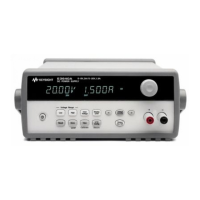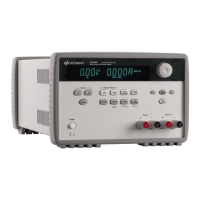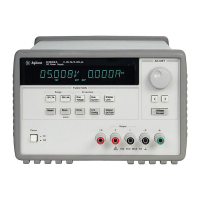Chapter 3 Front-Panel Operation and Features
Disabling the Output
59
3
Disabling the Output
The output of the power supply can be disabled or enabled from the front panel.
• When the power supply is in the “Off” state, the
OFF annunciator turns on and the
output is disabled. The
OFF annunciator turns off when the power supply returns
to the “On” state. When the output is disabled, the voltage value is 0 volts and the
current value is 0.02 amps. This gives a zero output voltage without actually
disconnecting the output.
• The output state is stored in volatile memory; the output is always disabled when
power has been off or after a remote interface reset.
• While the output is disabled, the control knob is locked to prevent from any
unwanted changes occurring. But the other front panel keys are working.
• To lock the control knob, move the flashing digit to the right or left using or
resolution selection keys until the flashing digit disappears.
To see or check the changes while the output is disabled, press before returning
to meter mode.
• Front-panel operation:
output Off
• Remote interface operation:
OUTP {OFF|ON}
Disconnecting the Output Using an External Relay
To disconnect the output, an external relay must be connected between the output and
the load. A TTL signal of either low true or high true is provided to control an external
relay. This signal can only be controlled with the remote command OUTPut:RELay
{OFF|ON}. The TTL output is available on the RS-232 connection pin 1 and pin 0.
When the OUTPut:RELay state is “ON”, the TTL output of pin 1 is high
(4.5 V) and pin 9 is low (0.5 V). The levels are reversed when the OUTPut:RELay
state is “OFF”. The TTL output of pin 1 or pin 9 of the RS-232 connector is available
only after installing two jumpers (JP1 and JP2) inside the power supply. See the
Service Information to locate them.
Note Do not use the RS-232 interface if you have configured the power supply to output
relay control signals. Internal components on the RS-232 circuitry may be damaged.

